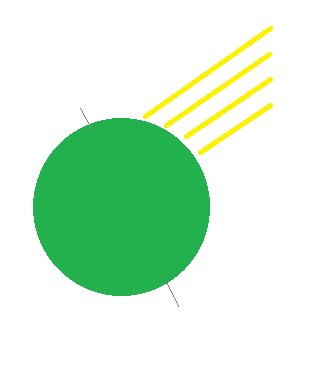What Does Full Sun or Part Shade Mean?
Plant sunlight requirements are often classified as full sun, partial sun, partial shade and shade. What do sun exposure classifications really mean?
There are general definitions that can apply to each classification for sunlight exposure, as a starting point:
Full sun: 6 or more hours of direct sunlight per day
Partial sun: 4 to 6 hours of direct sunlight per day, midday and afternoon
Partial shade: 4 to 6 hours of direct sunlight per day, morning and late afternoon
Full shade: 2 to 3 hours of direct sun per day or less
Sunlight Intensity Is Important
The time of day an area receives sunlight is important. Morning sun is not as intense as afternoon sun.

on geographic location
When you live in warmer climates closer to the equator, the sun’s rays are more intense and hotter than climates further from the equator. Plants that thrive in full sun in northern climates may need protection from midday sunlight exposure in southern climates.
For example, an area that receives only three to four hours of full sun in the afternoon may be sufficient for full sun plants because of the intensity of the sunlight.
Sunlight intensity should always be considered when determining suitability of a plant for a given location.
What is Full Sun?
Full Sun refers to an area that receives six to eight hours of direct sunlight exposure per day.
Full Sun Plants
Some full sun plants such as vegetables and perennials perform well with up to ten hours of direct sunlight exposure.
What is Partial Sun?
Partial Sun refers to an area that receives four to six hours of direct sunlight exposure per day, midday and afternoon.
Partial Sun Plants
Plants that are rated for part sun means the plant performs better with more sun and prefers sunlight exposure time to the higher end of the range (six hours). Partial sun plants can typically tolerate the intensity of midday sun exposure.
What is Partial Shade?
Partial Shade refers to an area that receives four to six hours of direct sunlight exposure per day, morning and late afternoon.
Partial Shade Plants
Plants that are rated for part shade means the plant performs better with less direct sun and prefers sunlight exposure time to the lower end of the range (four hours). Partial shade plants should receive morning or late afternoon sunlight exposure because it is less intense than midday.
Related: Flowering Vines For Shade
What is Full Shade?
Full shade refers to an area that gets two to three hours of sunlight exposure or only dappled sunlight exposure per day.
Dark areas may be caused by mature trees with spreading branches, or by buildings casting a permanent shadow on one particular area.
Some areas are shaded for only a few hours each day, others may have dappled sunlight filtered through trees, shrubs or climbers.
Very few plants can tolerate total darkness. Some light is essential for the process of photosynthesis, the method plants use to convert sun energy to food.
Too much sun or too much shade?
A plant that needs full sun will become stunted, pale and leggy in a shady location. Blossoms will look poor or not at all and it will be more vulnerable to insects and diseases.
Alternatively, a plant whose leaves become thin, and scorched by the sun may be better off in a shadier location. A plant that prefers shade will become bleached and stunted under full sun. It will be more vulnerable to insects and diseases too.
Understanding Plant Tags
Some plants will thrive in a wide range of growing conditions. Fortunately growers relay this to us through the information they provide on the plant tag.
Sometimes it can be confusing though, when there are double specifications for light requirements such as “shade to part shade” or “full sun to part shade”.
Here is how to understand light requirements on a plant tag with this example:
Plant tag “full sun to partial sun” meaning?
The first specification listed will be the most preferred light exposure for the plant – “full sun”
The second specification is acceptable but not the most preferred light exposure for the plant – “partial sun”
So now we know this plant prefers full sun, but will tolerate part sun conditions as well. If we have a partial sun location that gets sun for 6 hours, this plant would be a consideration for that location.
And just a reminder, to consider where you live and the effect of sunlight intensity on the plants before deciding.


What is meaning of label sun to shade please explain
Hi Manjitgoraya,
A plant tag that indicates sun to shade for the growing conditions of a plant means that the optimal growing conditions lean towards sun, but the plant can tolerate shade as well.
The first specification listed will be the most preferred light exposure for the plant – “sun”
The second specification is acceptable but not the most preferred light exposure for the plant – “shade”
Enjoy growing your plants!
Nancy